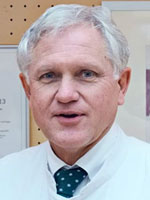New patient guideline on obesity therapy
14.10.2021
Gastric band, sleeve stomach or gastric bypass? And what is the difference between bariatric surgery and metabolic surgery? The recently published patient guideline "Diagnosis and Treatment of Obesity" answers these and other questions.
The guideline was developed by the scientist Regine Breneise, research assistant in the research project nutriCard at the SRH University of Health, Dr. Tatjana Schütz, Core Unit "Nutrition and Clinical Phenotyping" at the IFB Obesity Diseases, and Prof. Dr. Claudia Luck-Sikorski, head of the junior research group "Stigmatization and Internalized Stigma in Obesity" and Vice President of the SRH University of Health, as well as Prof. Dr. Sylvia Sänger, Professor of Health Sciences at the SRH University of Health.
The aim of the brochure is to present the recommendations from the medical guidelines in a patient-friendly and understandable manner. In this way, obese patients who are considering an operation can be supported in their decision-making, as it is important that patients are also aware of these recommendations.
At the same time, the exchange of information between practitioners and patients is facilitated. Like a reference work, the guideline guides those interested through the chapters "Preparing the decision for the operation", "Immediately before the operation" and "After the operation". Patient representatives from supraregional patient associations in the field of obesity and a multidisciplinary working group of ten mandate holders were also involved Medical scientific societies and associations The guideline is printed as a brochure and made available on the website of the Association of Scientific Medical Societies.
"The collaboration with representatives from national patient associations and a multidisciplinary working group of elected officials was a great enrichment! I am very pleased that the patient guideline can facilitate access to comprehensive information on obesity surgery or metabolic procedures Practice ”, said Regine Breneise, research associate in the nutriCard research project at the SRH University of Health. She is part of the COPE (Chronic Diseases and psychological health) research group at the SRH Health University, which deals with chronic diseases and mental health researched on areas such as obesity, cancer and diabetes.
Obesity Surgery: People with Diabetes Benefit Most
13.04.2020
In obese adults, metabolic bariatric surgery improves life expectancy compared to standard conservative therapy. The advantages for the prognosis are much more pronounced in obese patients with diabetes than in obese patients without diabetes.
Metabolic-bariatric interventions lead to significant weight loss, improve cardiovascular-relevant metabolic parameters and reduce the risk of cardiovascular complications in particular. The life expectancy of the operated patient is increasing. According to the authors of the present study analysis, however, more robust estimates of the effect on long-term mortality and life expectancy - especially stratified according to diabetes status - are needed to educate political decision-makers (and also payers) and patients about the benefits of such interventions in relation to conservative therapies. For this reason, the authors examined the long-term survival rates of severely obese patients who were treated either surgically or purely conservatively.
Meta-analysis with patient-level survival data from prospective controlled studies and high-quality matched cohort studies. Of 1470 identified publications, 16 matched cohort studies and one prospective controlled study were included in the analysis.
Among 65,785 patients who underwent surgery, 1,813 deaths occurred over a period of 496,771 patient-years. Among 108,987 matched non-operated patients, there were 5899 deaths over a period of 659,605 patient-years.
In the total population, metabolic bariatric surgery was associated with a 49.2 percent reduction in the death rate (95% CI 46.3-51.9, p <0.0001). Surgery participants lived a median 6.1 years longer than participants with usual care.
Subgroup analyzes showed lower all-cause mortality rates for people with (hazard ratio 0.409) and without diabetes (0.704) who underwent surgery; However, the treatment effect was significantly greater in diabetes patients: patients with diabetes who had operated on had a median life of 9.3 years longer than patients who were treated conservatively. Patients without diabetes gained a median age of 5.1 years as a result of the surgical therapy.
The number of treatments required (NNT) to prevent an additional death over a 10-year period was 24.4 and 10.8 over a 20-year period. For participants with diabetes, the NNT for a period of 10 years was 8.4 years (20 years 5.3), for participants without diabetes it was 29.8 (20 years 19).
The treatment effects did not seem to differ between gastric bypass, banding and sleeve gastrectomy.
According to the authors, the analysis has sufficient statistical power to be able to assess the long-term survival prognosis after metabolic-bariatric surgery. Another plus point of the analysis is that it contains information on the hazard ratio, the NNT and the median life expectancy. In addition, subgroup analyzes were carried out in order to differentiate the treatment effects according to one of the most important effect modifiers: type 2 diabetes.
Overall, the meta-analysis supplements the existing good data on the benefits of obesity surgery. On the one hand, the results should be of interest to policymakers who develop strategies to counter the increasing prevalence of obesity and diabetes; on the other hand, they can also be useful for general practitioners, endocrinologists and cardiologists in their daily communication with patients.
The results should also be of importance when it comes to evaluating the benefits of obesity surgery in comparison to new pharmacological therapies for weight loss (keyword: orally administered semaglutide, etc.).
Why obesity often requires surgery
24.06.2019
It is an "increasing" problem - and in the truest sense of the word: every fourth German is considered too thick, and the trend is rising. "One of the reasons is that food can be obtained anytime, anywhere, even in large quantities and at a relatively low price," says Professor MD Thomas Carus. "On the other hand, you hardly have to move today if you do not want to. You sit at home on the sofa, eat chips and watch movies for hours. You do not even have to go to the cinema anymore," says the head of the surgery, who heads the Asklepios Westklinikum in Rissen, the center for obesity, which is called "obesity in jargon".
From a body mass index (body weight in kilograms divided by height squared) of more than 40, a patient is considered morbidly obese. "Concrete example: A woman who is 1.70 meters tall and weighs 130 kilograms is morbidly obese," says the physician whose heaviest patient weighed in at 320 kilograms. Of course, the equipment in the operating room must be designed for this, because a conventional table only carries patients up to 135 kilograms.
But what happens before an operation? "A rigorous diet. It must first be tried in a conservative way to drastically reduce the weight," says surgeon Carus, who habilitated in Dresden at the University Hospital Carl Gustav Carus - named after a famous ancestor. "Every kilo less helps! Because although no one dies of obesity, but thousands of concomitant diseases. The risk of having a heart attack or stroke and developing diabetes is extremely high. One can say: If the body mass index is over 40, one lives on average ten to 15 years less."
However, losing weight is not easy, the fight against the kilos a marathon of discipline. Most of his patients - 20 a week sees Carus in the Obesity Center in cracks - would have tried all kinds of diets. "Some take off wonderfully even in a spa clinic, but back in the wild, the yo-yo effect beats mercilessly." Therefore, an accompaniment to the diet is essential, the expert said. "The current model is designed for six months and is based on three pillars: nutritional counseling, exercise therapy and behavioral therapy." However, the balance makes little hope: Not even half of all patients manage to lose so much weight in this time that surgery no longer necessary.
So is the gastric band left? "No, we just build them out," says the cracker and laughs. In the 1990s, this was the operation of choice, but today many of the gastric bands installed at the time made mechanical problems. "In addition, the system is too easy to cheat. You can still pour gallons of cola or drink chocolate. Although the stomach is encased by a foreign body, but preserved in full size and waiting for delivery."
Meanwhile, the so-called hose stomach has prevailed worldwide. "The stomach is reduced in this fairly easy, about 30-minute keyhole surgery, so that the patient later feels a stretch stimulus after a few bites, the saturation begins faster." A good quarter of the original weight lose most patients after. However, personal responsibility is also the key to success here. "Because of course you can with a lush, greasy food, the tube stomach to break easily," warns the passionate kite-surfer, who likes to go to the Baltic after a long day in the clinic, "again for two hours on the board to rise".
In obese patients with diabetes that is difficult to control or heartburn, the gastric bypass is often chosen instead of the tube. "However, this procedure alters the metabolism and is complicated in the aftercare, because one relies on food supplements."


























 Loading ...
Loading ...


